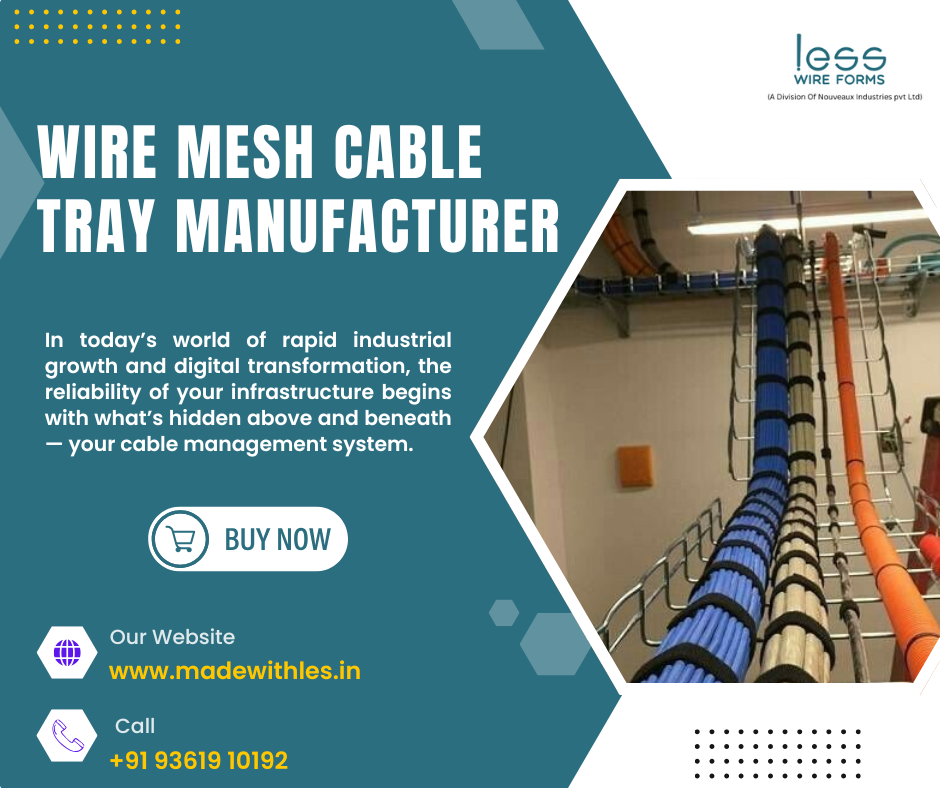When we think of modern infrastructure, our minds often jump to soaring skyscrapers, vast data centers, and sprawling transportation hubs. We marvel at the glass, steel, and smart technology. But beneath the surface, quite literally, lies a silent, unsung hero that makes it all possible: the wire mesh cable tray.
And behind these trays are the wire mesh cable tray manufacturers, the true backbone of our connected world. They don’t just bend metal; they engineer the circulatory system for the lifeblood of the 21st century—data and power.

The Unsung Hero: What is a Wire Mesh Cable Tray?
Before we dive into the “why,” let’s clarify the “what.” A wire mesh cable tray is a robust, lightweight, and ventilated system made from welded steel or stainless steel wires. Unlike solid-bottom trays, their open design offers unparalleled flexibility, visibility, and airflow.
Think of them as the high-tech, heavy-duty version of a office cable organizer, but scaled up for industrial and commercial use.
6 Reasons Why Manufacturers are the Backbone
Manufacturers don’t just produce a commodity; they solve critical challenges for architects, engineers, and project managers. Here’s how:
1. Enabling Flexibility and Future-Proofing
Modern infrastructure is dynamic. A building’s cabling needs can change overnight. Wire mesh trays allow for easy adds, moves, and changes. Manufacturers design systems with this in mind, creating trays that are modular and easy to modify without specialized tools. This future-proofing is essential in data centers and labs where downtime is measured in thousands of dollars per minute.
2. Ensuring Superior Safety and Durability
This is non-negotiable. Reputable manufacturers use high-tensile steel and precision welding to create trays that can support significant weight and withstand harsh environments. Their open design prevents the accumulation of dust, gases, and heat, reducing fire risk. Furthermore, they provide the essential pathways that keep cables organized and away from potential damage, which is a cornerstone of electrical safety codes.
3. Maximizing Efficiency with Optimal Airflow
Heat is the enemy of electrical efficiency. In a server rack or a control panel, trapped heat leads to higher energy costs for cooling and reduces the lifespan of sensitive equipment. The open-mesh design acts like a natural ventilation system, allowing heat to dissipate efficiently. Leading manufacturers engineer their trays to maximize this airflow, directly contributing to lower operational costs and a smaller carbon footprint.
4. Providing Unmatched Visibility and Accessibility
Troubleshooting a fault in a tangled, concealed cable run is a nightmare. Wire mesh trays solve this by offering complete visibility of the entire cable run. Maintenance teams can quickly identify issues, perform repairs, and conduct routine inspections without a lengthy discovery process. This accessibility, designed into the product by the manufacturer, translates directly into reduced maintenance time and cost.
5. Offering Lightweight, Yet Strong Solutions
Compared to solid sheet metal trays, wire mesh variants are significantly lighter. This might seem like a small detail, but it has a massive ripple effect. It simplifies the installation process, reduces the structural load on the building itself, and can lower shipping costs. Innovative manufacturers are constantly refining their designs to achieve the perfect strength-to-weight ratio.
6. Supporting Sustainability Goals
Modern infrastructure is increasingly green. Wire mesh cable trays align perfectly with this ethos. They are typically made from recyclable materials, and their long service life and reconfigurable nature mean less waste ends up in landfills. By enabling energy-efficient cooling, they contribute to a building’s overall sustainability profile.
Choosing the Right Partner: It’s More Than Just a Product
Not all manufacturers are created equal. The “backbone” is formed by those who go beyond mere production. They provide:
- Custom Engineering: The ability to design custom brackets, radii, and sizes for unique project requirements.
- Technical Expertise: Support from knowledgeable engineers who understand NEC, IEC, and other global standards.
- Quality Assurance: A commitment to consistent quality, often backed by certifications like ISO 9001.
- Reliable Supply Chain: The capacity to deliver on time, keeping massive infrastructure projects on schedule.
Conclusion: The Framework of a Connected Future
From the fiber optics that power our internet to the control cables that run our subways and the power lines in our hospitals, wire mesh cable trays are everywhere. They are a fundamental, though often invisible, component.
The companies that design and manufacture these systems are not just suppliers; they are essential partners in progress. They provide the critical infrastructure that holds up our digital world. So, the next time you walk into a state-of-the-art building or rely on a seamless digital service, remember the engineered backbone that makes it all work—thanks to the innovation and expertise of wire mesh cable tray manufacturers.
